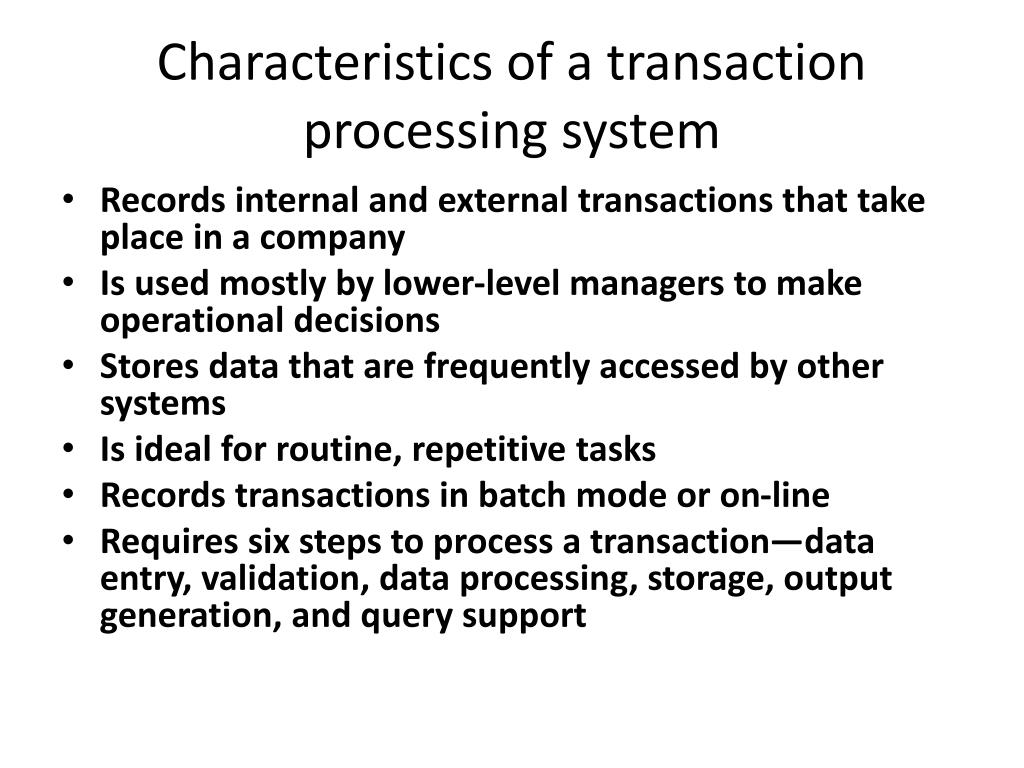


They also feature rapid online transaction processing time, with response times measured in milliseconds, and indexed data sets for rapid retrieval, searching, and querying. OLTP systems feature several common characteristics, including the ability to ensure data integrity while processing huge numbers of relatively simple, concurrent transactions at once. What are Online Transaction Processing Databases? The database must achieve atomic statefulness and ensure all changes to it are permanent to guarantee transactions are completed successfully. Atomicity guarantees the process will not continue if one step fails or is incomplete during the transaction. Concurrency prevents many users from altering the same data simultaneously. Two key characteristics of online transaction processing systems are concurrency and atomicity. Many everyday acts involve OLTP, including online banking and online shopping.
#A transaction processing system is software#
Online transaction processing is a type of software that supports transaction-oriented applications. Online Transaction Processing FAQs What is Online Transaction Processing? It also creates data silos–a natural result of the way online transaction processing architecture gives an OLTP database to each application. First, it generates massive amounts of raw data.

Transferring data between applications with OLTP is very useful, but handling data with OLTP databases creates challenges. In-memory online transaction processing requires memory-optimized tables and efficient access to them. Online transaction processing can process concurrent transactions and queries very quickly, responds to user actions immediately, and allows users to perform operations like read, write and delete data rapidly. (These will be discussed in more detail below.) This is a critical function, because transaction data stored in the system is essential for data-driven decision making, reporting, compliance, and other functions.īecause OLTP systems typically serve many users and access mission-critical data via applications such as online shopping carts, they demand tight security protocols and extremely high availability.Ĭoncurrency: the ability to handle many transaction requests simultaneouslyĪtomicity: the ability to backup and continue in the event of system failure reliably It is typically a mobile, web, or enterprise application that tracks all those user transactions and interactions and updates the store. The basic foundation for most OLTP systems remains economic or financial transactions-so online transaction processing typically involves managing, collecting, and securing those transactions by updating, inserting, and/or deleting small amounts of data in a data store, the OLTP database. Some in-memory OLTP databases can avoid pulling transaction data from disk storage and can instead process memory-optimized tables of transaction data stored in system memory. How does online transaction processing work? Typically, OLTP involves updating a database by inserting or deleting small bits of data. It also includes things like viewing a specific video, downloading pdfs on a web page, or other online interactions. Since the advent of the internet online transaction processing has expanded to encompass any kind of digital engagement or interaction with a business via any web-connected sensor from anywhere in the world. However, numerous everyday applications involve OLTP, such as in-store point of sale (POS) terminals tied to inventory management software, sending text messages, online shopping, or other economic or financial transactions. In computing, a transaction is a discrete data or information sequence.ĪTMs and online banking are a common online transaction processing example. Online Transaction Processing (OLTP) is a type of data processing that supports transaction-oriented applications online.


 0 kommentar(er)
0 kommentar(er)
